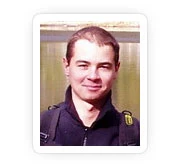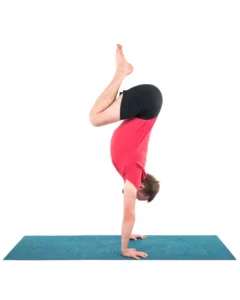Yoga Anatomy: Best Muscle Actions to Prepare for Full Arm Balance and Upward Bow Pose

Learn how to engage the muscles of the forearms, wrists and hands to prepare for challenging arm balances like full Handstand or backbends like Urdhva Dhanurasana (Upward Bow Pose).
Explore this first in Adho Mukha Svanasana (Downward Facing Dog Pose) to get a feel for it. Then, if you are experienced with Adho Mukha Vrksasana (Full Arm Balance or Handstand), try balancing these forces while using a wall for support.

-
Gently press the mounds at the base of the index fingers into the mat and slightly flex the wrists. This engages the muscles that “pronate” the forearms or turn the palms to face down—the pronators teres and quadratus and the flexor carpi radialis.
-
Then spread the force evenly across the palms to the little finger side of the hands. This engages the muscles that “supinate” the forearms or turn the palms to face up—the biceps and supinator.
-
Gently attempting to drag the hands toward one another activates the biceps.
-
You can refine supination by extending the thumbs up and away from the mat for a moment and then laying them back down. This engages the extensor pollicis longus.
-
Feel how these actions balance the energies of the forearms, wrists, and hands. This technique can also be useful in Urdhva Dhanurasana (Upward Bow Pose).
-
Always practice poses such as these under the direct guidance of a qualified instructor. If you experience pain in the wrists in either of these poses, come out of the asana. If the pain persists, consult your healthcare provider.

Anatomy for Pronators and Supinators of the Forearm and Wrist: 
The pronator teres has two heads: the humeral head originates from the medial epicondyle of the humerus and the ulnar head originates from the coronoid process of the ulna. Both heads combine into one tendon that inserts onto the lateral surface of the radius. This muscle acts to pronate the forearm (turn the palm to face down). It can also assist in flexing the elbow. The pronator quadratus originates from the distal quarter of the anterior surface of the ulna and inserts onto the distal quarter of the anterior radius. It acts to pronate the hand and stabilize the wrist.
The flexor carpi radialis longus originates from the medial epicondyle of the humerus and runs diagonally across the forearm to insert onto the base of the second metacarpal bone of the hand. It acts to flex the wrist and abduct (radially deviate) the hand and assists in pronating the forearm.
 The supinator originates from the lateral epicondyle of the humerus, lateral collateral ligament of the elbow, annular ligament of the radio-ulnar joint, and olecranon process of the ulna (see image). It inserts onto the back (dorsum) and lateral surfaces of the upper third of the radius. The supinator acts to supinate the forearm (turn the palm to face up).
The supinator originates from the lateral epicondyle of the humerus, lateral collateral ligament of the elbow, annular ligament of the radio-ulnar joint, and olecranon process of the ulna (see image). It inserts onto the back (dorsum) and lateral surfaces of the upper third of the radius. The supinator acts to supinate the forearm (turn the palm to face up).
The extensor pollicis longus originates from the middle part of the posterior surface of the ulna and the interosseous membrane that runs between the radius and ulna. It inserts onto the dorsal surface of the distal phalanx of the thumb. Click here to learn about the anatomy of the bicep muscles.
More yoga asana practice tips and inspiration from Ray Long, MD – Connect Your Cuff, Save Your Wrists in Plank Pose.
Reprinted with permission from Daily Bandha.com
anatomy images courtesy of Daily Bandha.com
 Author Ray Long MD, FRCSC is a board-certified orthopedic surgeon and the founder of Bandha Yoga. Ray graduated from The University of Michigan Medical School with post-graduate training at Cornell University, McGill University, The University of Montreal and Florida Orthopedic Institute. He has studied hatha yoga for over twenty years, training extensively with B.K.S. Iyengar and other leading yoga masters.
Author Ray Long MD, FRCSC is a board-certified orthopedic surgeon and the founder of Bandha Yoga. Ray graduated from The University of Michigan Medical School with post-graduate training at Cornell University, McGill University, The University of Montreal and Florida Orthopedic Institute. He has studied hatha yoga for over twenty years, training extensively with B.K.S. Iyengar and other leading yoga masters.
 3d Graphic Designer / Illustrator Chris Macivor has been involved in the field of digital content creation for well over ten years. He is a graduate of Etobicoke School of the Arts, Sheridan College and Seneca College. Chris considers himself to be equally artistic and technical in nature. As such his work has spanned many genres from film and television to video games and underwater imagery.
3d Graphic Designer / Illustrator Chris Macivor has been involved in the field of digital content creation for well over ten years. He is a graduate of Etobicoke School of the Arts, Sheridan College and Seneca College. Chris considers himself to be equally artistic and technical in nature. As such his work has spanned many genres from film and television to video games and underwater imagery.



